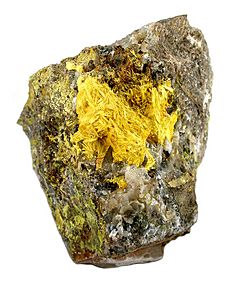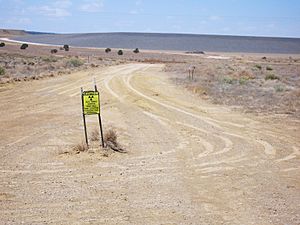Ambrosia Lake facts for kids
Ambrosia Lake is a special area in New Mexico. It's located near the town of Grants. This place became very important in the 1950s. Why? Because a lot of uranium was found there! Uranium is a metal used to make energy. The area is shaped like a big dome, which is called an anticlinal dome.
Contents
Discovering Uranium at Ambrosia Lake
In 1955, a company called Kerr-McGee learned about the rich uranium. They offered a free service to test rock samples. Some people sent in samples from Ambrosia Lake. These samples had a lot of uranium!
Kerr-McGee wanted to buy the land. But their agent tried to buy it for himself. Other companies also rushed to get parts of the land. But in the end, Kerr-McGee owned most of the Ambrosia Lake area.
Mining Companies and Changes
Kerr-McGee then joined with other companies. They formed a new company called Kermac Nuclear Fuels Corporation. This company built a large factory, called a mill, at Ambrosia Lake. This mill processed the uranium.
Later, in 1983, Kerr-McGee Nuclear split into two smaller companies. One was called Quivira Mining. Quivira Mining took over the Ambrosia Lake property. Then, in 1989, Quivira Mining was sold to another company called Rio Algom. Rio Algom got the mine and the mill. Later, Rio Algom became part of a very large company called BHP Billiton.
Cleaning Up the Area
After almost 25 years of mining, a lot of radioactive waste was left behind. This waste is called tailings. By 1982, about 111 acres (0.45 square kilometers) of these tailings were left. Wind and rain spread this material over a much larger area. It covered about 230 acres (0.93 square kilometers).
Making the Site Safe Again
The Department of Energy worked to clean up the site. This cleanup happened between 1987 and 1995. They gathered a huge amount of contaminated material. It was about 5.2 million cubic yards (4 million cubic meters). They put all of this material into a special storage area. This area is called a disposal cell. It covers about 91 acres (0.37 square kilometers).
The Department of Energy's site is now closed. However, the old Kermac mill, which is now owned by BHP, is still being cleaned up. They are working towards finishing their cleanup by 2021. Other cleanups in the area are managed by the Environmental Protection Agency (EPA).



